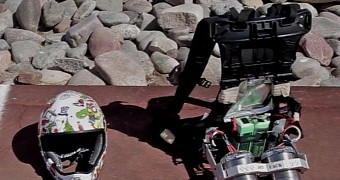Straight from the deepest corners of a group of technology enthusiasts' brains comes a jetpack that promises to turn folks into a cartoon character that's both admired and loathed: the Road Runner.
This jetpack promises to help people run faster than they could, were they to rely on their bodies alone. Hence, the wacky high-tech backpack is expected to forever change the face of sports that are all about moving as fast as possible.
The 4 Minute Mile project
This one-of-a-kind jetpack is the brainchild of a team of engineering and robotics specialists with the Arizona State University in the US. A photo of a fully functional prototype is available next to this article, and you are more than welcome to check it out.
What's interesting it that, when they first started work on their innovative jetpack, the specialists behind this research project did so at the request of the country's Defense Advanced Research Project Agency, that was looking to find a way to help soldiers move faster on the battlefield.
Not too long after the researchers got to work, the Agency decided that it was no longer interested in this project, and chose to fund another one instead. Before you let out one or two sighs, you should know that this is actually a good thing.
Thus, since the Defense Advanced Research Project Agency no longer cares about this jetpack, its creators can do what they please with this technology, even make it available to the public sometime in the not-too-distant future. Sport enthusiasts are the ones most likely to take an interest in it.
How the jetpack works
As detailed by Live Science, the Arizona State University specialists hope to eventually develop a jetpack that can help its wearer run 1 mile (approximately 1.6 kilometers) in just 4 minutes.
Information shared with the public says that the high-tech backpack works by generating a propulsive force that makes the wearer move forward faster than they normally would. The force that this jetpack produces is enough to make up for the added weight resulting from the fact that the wearer has it on their back.
“When the jetpack is on your back, it's creating about 15 lbs. [6.8 kilograms] of thrust, which is essentially like somebody pushing you from behind with about 15 lbs. of force,” researcher Jason Kerestes told the press in an interview.
“Too little doesn't help enough, and too much is actually hurtful because it doesn't make you run faster, it makes you fall over. There's a unique proportion to body weight and the amount of force that works best, and we found that to be about 10 to 15 percent of your body weight,” he added.
Not too long ago, a prototype jetpack was used to help a volunteer run 1 mile (1.6 kilometers) in 5 minutes and 2 seconds rather than 5 minutes and 20 seconds, which is how much it took him to complete this distance on his own.
Admittedly, there is plenty of work left to do and it will surely be a while until such jetpacks become available to the general public. Still, the results the scientists behind this project have thus far obtained are quite impressive and definitely encouraging, so maybe we won't have to wait until forever to have science turn us into featherless Road Runners.

 14 DAY TRIAL //
14 DAY TRIAL //